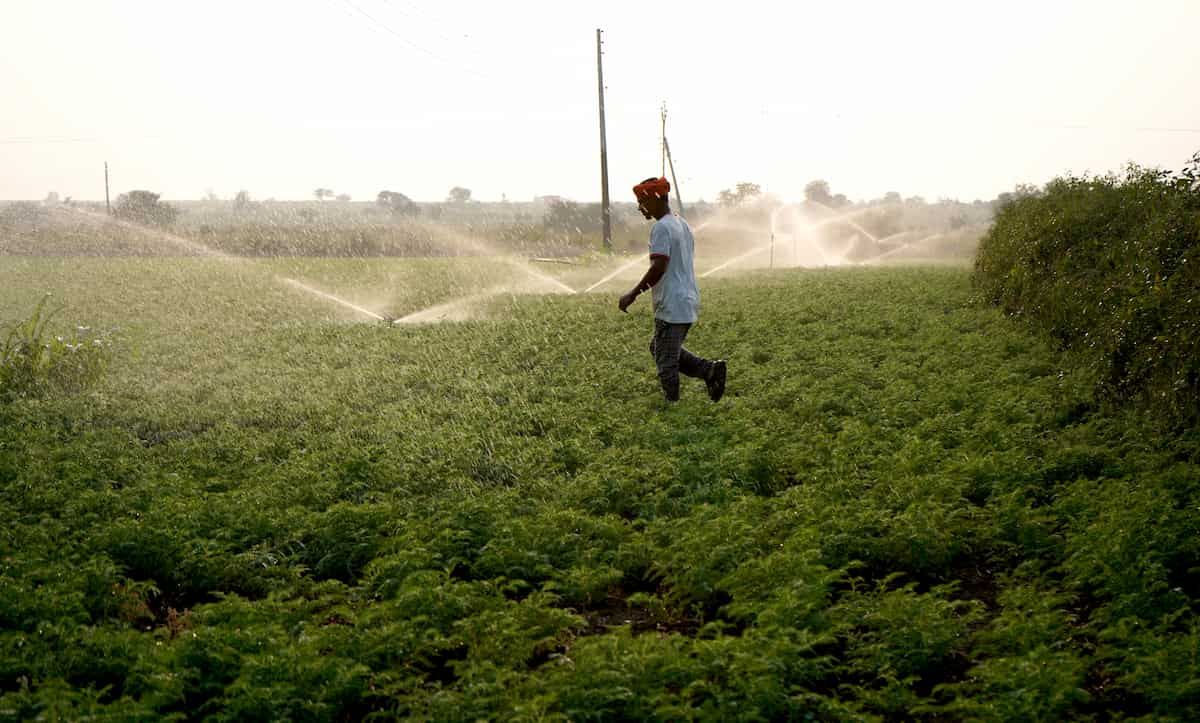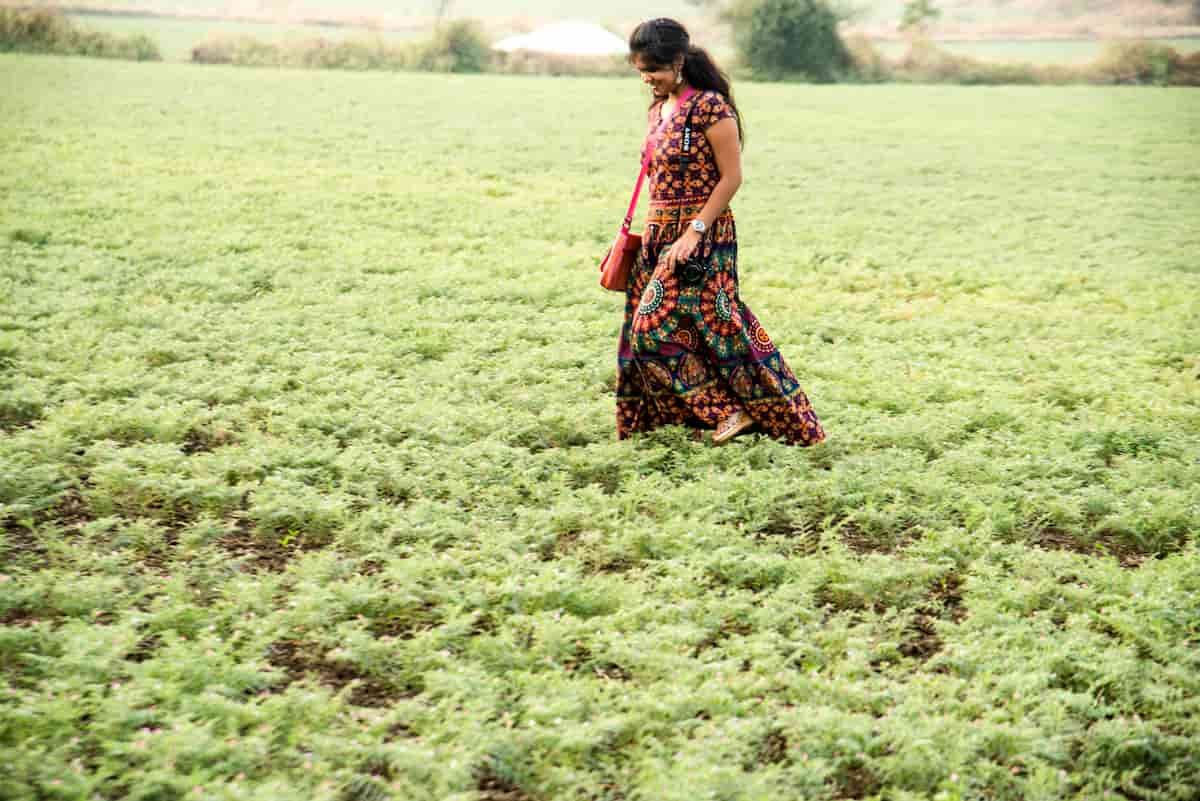Chickpea, or Bengal gram, is India’s most important pulse crop, occupying 38% of the pulse production area and contributing 50% of the total production. It is versatile and can be consumed whole, boiled, fried, or as a split pulse. Chickpea leaves and straws are valuable cattle feed, while chickpea flour (besan) is used in sweets. It is also considered to have medicinal effects for blood purification. Chickpea is rich in protein (21.1%), carbohydrates (61.5%), calcium, iron, and niacin, making them a valuable crop for human consumption and animal feed.

Chickpeas (Chana Dal) Production
Best Package and Practices of Chickpeas High Production
- Using certified seeds
- Proper land preparation
- Sowing at the right time
- Providing adequate irrigation
- Using balanced fertilizers
- Timely weeding
- Pest and disease management
Additionally, adopting intercropping with cereals or legumes can increase yield and soil health. Proper harvesting, threshing, and storage practices also ensure high-quality produce. Regular monitoring, documentation, and farmer training on good agricultural practices can improve chickpea production.
Land/ Field Preparation and Soil Requirements for Chickpeas
Chickpea is a versatile crop that can be grown on a wide range of soils in India, from moderately heavy soils in the north to black cotton soils on the Deccan plateau and light sandy loams in Punjab, Uttar Pradesh, Haryana, and Rajasthan. However, well-drained sandy loam to clay loam soils is considered most suitable. Chickpea can tolerate pH levels from 6.0 to 9.0 but is sensitive to salinity and alkalinity. Fertile sandy loam and well-drained soils are best for chickpea growth.
Temperature, Climatic, and Rainfall Requirements for Chickpeas
Chickpea is a cool season annual crop that grows well under good moisture conditions with ideal temperatures between 24º-30ºC. It can be grown under irrigated and rainfed conditions, but excessive rains soon after sowing, at flowering and fruiting, or hailstorms at ripening can cause heavy losses. Chickpea is best suited for areas with moderate rainfall of 60-90 cm per annum and prefers a daily cycle of cool (17.8°-21°C) nights and warm (21°-26.7°C) days. This crop is sensitive to frost, especially at the flowering stage, which can damage seed development in the pod.
Propagation Method and Seed Quality for Chickpeas
Chickpea is propagated through seeds that should be certified and of good quality, with a high germination rate and free from diseases.
Seed Treatment for Chickpeas
To improve chickpea crop yield, treating the seeds before sowing is recommended. One method is to treat 10 kg of chickpea seed with 250 gm of Rhizobium biofertilizer to promote nitrogen fixation. Another method is to treat the seeds with 250 gm of phosphate-solubilizing bacteria to enhance phosphorus availability. To control wilting, the seeds can be treated with 5 gm of Trichoderma, applied to 1 kg of seed. These treatments can help improve seed germination, plant growth, and disease resistance, resulting in higher chickpea yields.
Seed Rate and Spacing for Chickpeas
The recommended sowing method for chickpeas uses a seed drill or local plow with a row spacing of 30-40 cm. Depending on seed size, a 75-100 kg seed rate per hectare is recommended for optimal growth. Placing the seed at an 8-10 cm depth is essential to ensure proper germination and growth.
In case you missed it: Lentil Production Guide: A Step-By-Step Cultivation Practices

Sowing Method for Chickpeas
Proper sowing depth and spacing are crucial for achieving optimal chickpea productivity. Two methods of sowing are broadcasting and line sowing, with line sowing having a recommended row-to-row distance of 40 cm.
Crop Rotation and Intercropping in Chickpeas
Chickpea is often grown in rotation with cereal crops to help control soil-borne diseases. Common cropping systems include Kharif fallow-chickpea in barani areas, rice-chickpea, pearl millet-chickpea, sorghum-chickpea, and maize-chickpea. Intercropping flax and chickpea has the potential to expand the area of economic adaptation for both crops, with flax expanding into drier areas and reducing disease severity in chickpeas, while an intercrop with flax can reduce risk and provide yield stability for chickpeas in wetter regions
Manure & Fertilizer Applications in Chickpeas
Chickpeas get 75% of their nitrogen from symbolic nitrogen fixation, but low organic matter soils may require a starter dose of 20-25 kg of nitrogen per hectare. Phosphorus is also important, and diammonium phosphate (18-46-0) at 100-150 kg per hectare can be applied before the last discing plowing. Potassium application has had inconsistent results. Fertilizers should be drilled at a depth of 7-10 cm in furrows to improve nutrient uptake and crop growth.
Weed Management and Herbicide Application in Chickpeas
Weed infestation can significantly reduce chickpea yield. Effective weed control can be achieved through hand weeding or inter-cultivation with a hand or wheel hoe after 25-30 days of sowing, followed by a second if necessary. Alternatively, a pre-planting spray of Fluchloralin (Basalin) at a rate of 1 kg per hectare in 800-1000 liters of water can be used as an effective herbicide. It should be well incorporated into the soil before sowing. If Basalin is not available, Metribuzin or Prometrynen at a rate of 1.0-1.5 kg active ingredient in 800-1000 liters of water per hectare can be used as a pre-emergence spray
Water Management in Chickpeas
Chickpea is mainly grown as a rainfed crop and requires light irrigation to avoid excessive vegetative growth that can reduce yield. Pre-sowing irrigation is required for better seed germination if cultivated under irrigated conditions. One irrigation each at the pre-flowering, flowering, and pod-developing stages may be necessary for the absence of rain.
Disease Control in Chickpeas
chickpea is susceptible to several diseases caused by fungi. Fusarium wilt, caused by Fusarium orthoses, is a significant cause of yield loss in gram-growing regions. The disease causes yellowing and drying of leaves and plants, blackening, and decomposition of roots. Control measures include treating the seed with fungicides, avoiding early sowing, deep planting, and crop rotation.
Sclerotinia blight, caused by Sclerotinia sclerotiorum, affects all plant parts except roots and can be managed through disease-resistant seeds, soil treatment with fungicides, and the destruction of diseased plants after harvest. Grey mold, caused by Botrytis cinerea, can be controlled by late planting and spraying with carbendazim. Rust, caused by Uromyces ciceris arising, can be managed by spraying with Mancozeb 75 WP and planting resistant varieties. Ascochyta blight, caused by Ascochyta rabi, can be prevented by treating the seed with fungicides.
Pest Control in Chickpeas
The Gram cutworm is a pest that causes damage to crops by cutting plants at ground level. It can be controlled by applying Lindane 6% granules at a rate of 20-25 kg per hectare mixed in the soil. The Gram Pod Borer is the most serious pest of chickpeas, causing up to a 75% reduction in yield. Control measures include spraying Monocrotophos or Endisulfan during pod formation and repeating as needed after 15 days.
In case you missed it: Rajma/Kidney Beans Production Guide: A Step-By-Step Cultivation Practices

Harvesting and Threshing of Chickpeas
When the leaves of the chickpea crop turn reddish-brown and start falling off, it indicates that the crop is ready for harvesting. The plants should be plucked by hand or using a sickle to harvest. After harvesting, the crop should dry in the sun for around a week. Threshing can be done by beating the plants with sticks to separate the grain from the plant material.
Chickpeas Yield per Acre
Chickpea crops can result in a significantly higher yield than the national average. With effective management techniques, the crop can yield around 20-25 quintals of grain per hectare, approximately three to four times more than the national average.
Conclusion
Chickpea cultivation requires proper land selection, timely sowing, nutrient management, irrigation, and pest management. With good management practices, chickpea has the potential to yield higher than the national average, providing a good source of income for farmers.
- Feed Your Flock for Less: Top 10 Tips to Save on Chicken Feed
- Ultimate Guide to Ossabaw Island Hog: Breeding, Raising, Diet, and Care
- Hatching Answers: The Top 10 Reasons Your Chickens Aren’t Laying Eggs
- Eggs and Economics: Breaking Down the Cost of Raising Backyard Chickens
- Defend Your Greens: Proven Methods to Keep Iguanas Out of Your Garden
- Ultimate Guide to Cinnamon Queen Chicken: A Comprehensive Guide for Beginners
- Ultimate Guide to California Tan Chicken: Breeding, Raising, Diet, Egg-Production and Care
- Ultimate Guide to Marsh Daisy Chicken: Breeding, Raising, Diet, and Care
- 10 Types of Chicken Farming Businesses You Can Start for Profits